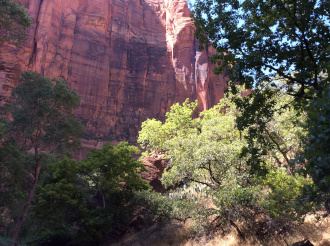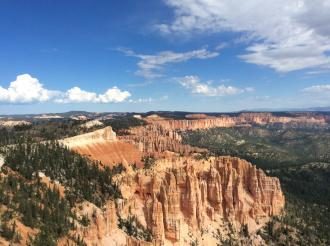By Matthew Mausner – Deep ecology is a movement and approach to living that pursues respect, compassion and balance between people and all species. There were always ways of life that might be loosely called deep ecology. People like American Indian groups embedded their lives and beliefs in close relationship to nature. Groups like the Amish practice ‘organic agriculture’ and forms of related full cycle permaculture. A few iconoclastic writers and philosophers like Henry David Thoreau and John Muir held the wholeness of nature as a high value.
Galvanized by Rachel Carson’s famous 1961 book “Silent Spring” about the impacts of DDT on birds, a genuine movement arose that questioned the rampant industrialization and expansion of Western civilization. Pollution, habitat destruction, and many other negative ‘externalities’ to the economy were recognized as serious problems in need of regulation and remediation.
The movement won significant early victories in the U.S., like the banning of the pesticide DDT, and passage of the Clean Air and Water acts. But some thinkers and activists believed that this type of response to the impacts of industrial civilization did not go far enough.
Edward Abbey, an itinerant park ranger and fire scout in the American West starting in the 1960s, wrote a set of fictionalized books about a group of highly motivated activists who engaged in direct action to protect old growth trees, pristine deserts and mountains, and endangered habitats fast succumbing to the encroachments of mining, logging, sprawl, and tourism. Abbey’s book ‘Monkey Wrench Gang’ threw a proverbial ‘monkey wrench’ in industry’s consumption of nature.
What is deep ecology?
A set of more comprehensive philosophies began to form around these principles and around the intuition of a fabric of wholeness to nature. The term “deep ecology” was coined by Norwegian philosopher Arne Naess in 1972 to describe and empower these idealists.
As Dr. Peter Madsen defines it, “Deep ecology distinguishes itself from other types of environmentalism by making broader and more basic philosophical claims about metaphysics and social justice. Sometimes called an “ecosophy,” deep ecology offers a definition of the self that differs from traditional notions and is a social movement that sometimes has religious and mystical undertones.”
Deep Ecology and A Language Older Than Words
Thinkers such as Derrick Jensen and Lierre Keith became notable proponents of the movement. Jensen’s seminal book A Language Older Than Words explores human relationships to all the nonhuman life around us, speculating and questioning why and how most modern humans in civilization have become so alienated from all these other species around us. If only human interests are driving our interactions, if the intrinsic value of non human life-forms are not respected by humans except to satisfy vital human needs, human life becomes very lonely- and very dangerous to the rest of the web of life around us.
Deep Communication with Animals
In the preface to his book, Derek Jensen described a small event that sparked his desire to write his book: he had been raising chickens and ducks, and discovered that coyotes were coming and breaking into the coop and eating them when Jensen was not nearby supervising. One time when he actually saw a coyote nearby stalking his chickens. Out of a sort of frustration, he asked the coyote to stop stalking and eating his chickens. As he then recounts, the coyote did stop, and neither it nor its pack members returned. While he was skeptical that it ‘meant anything’, it fed a growing suspicion that “interspecies communication might be real.”
At first he thought he was crazy, as this went against ‘official narratives’ in school, church, science, all of our dominant conception of ourselves as the only ‘sentient’ beings. But over time, he shared this story with people and asked if they had experienced anything similar, and found that more often than not, the answer was… yes. They also had experienced what they described as real, two-way communication, with “pigs, dogs, squirrels, even rivers, trees, and rocks!”
Deep Fear and Suppression
Yet those he shared with, too, feared that if they shared these stories then other people would think they were crazy. He began to wonder if this was a widely shared intuition and experience that was actively being suppressed. Looking back at the expansion of civilization, the subjugation of nature along with the more widely discussed stories of subjection of women, or of enslaved people, or of various ethnic groups, came into focus. As he puts it, “if the salmon or the chickens or the forests could write a book, what would it be like?”
Other Species and Deep Ecology
This insight led Jensen, and other thinkers including Lierre Keith, Stan Goff, John Zerzan, and others, to explore these ideas in deeper directions. Anthropology from important contributors like Marshall Sahlins had noticed that most hunter-gatherers seemed to live in an abundant state he called the ‘original affluent society’, with a sort of full-field awareness and perception of all the species around them, all the plants, birds, animals, insects, and even their annual cycles and songs and migrations.
These deep ecologists asked- how did we stop paying attention? How had we numbed ourselves to our own experience of the voices and vital, intentional lives of all the non-human life around us? How had we ‘tuned out’? And what were the consequences of that tuning out- what harm did it cause?
Deep Ecologists Ask: What if humans aren’t the center?
Many of the philosophies, disciplines, and movements of the 20th century have had holistic aspects, and have made more space for environmental concerns. But in the point of view of the deep ecologists, these other approaches suffer from being too shallow. As Henry David Thoreau said, “for every hundred people hacking at the branches of the tree of evil, one person is hacking at the roots.”
While any of these other movements that work on the flourishing of human society with respect to reducing injustice, or improving the rights of women and of oppressed minorities, might appear to be good things, if they implicitly allow business as usual to continue in a way that consumes and destroys the richness and diversity of all the non-human nature, then deep ecology would still place them on the side of ‘part of the problem.’
Deep ecology asks us to reconsider the fundamental relationship humans have with nature, and to question if even something like industrial civilization itself, that most of us take for granted, is itself a monumental assault on the wholeness of life on earth.
John Zerzan and some other ‘primitivists’ take this exploration even further. They note anthropological and archaeological evidence that human society was small-scale, peaceful bands for many millenia before civilization, who may have even had bigger brains and higher intelligence than humans in the most recent 6,000 years since large-scale civilization expanded. He posits that division of labor, hierarchy, and even something as seemingly basic as language, were all steps ‘down’ from that optimal engaged, holistic interaction of humans with the environment and with each other.
The Garden of Eden and a Deeper Ecology
Religious traditions have always had an ambivalent attitude about civilization, and about controlling or dominating nature. The story of the Paradise in the Garden of Eden is deeply familiar and rings true for many people because it clearly is at least built in part on aspects of the true history detailed above, however many generations removed from it we may be now. Jewish tradition details how animals could speak to humans in the garden, that all of the web of life was ‘up one level’ of consciousness; this would seem to corroborate Jensen’s insights.
Genesis 2:19 and Deep Ecology
Genesis chapter 2 verse 19 states “And the Lord God formed out of the earth all the wild animals and all the birds of the sky, and brought them to the man to see what he would call them; and whatever the man called each living creature, that would be its name.”
As Rabbis Yonatan Neril and Leo Dee write in Eco Bible: Volume 1: An Ecological Commentary on Genesis,
God created animals after people in the second creation story, with the purpose of Adam naming the animals. Adam was engaged in a relationship of recognition and non-violent interaction: I-Thou, not I-It. Today, encountering meat in a supermarket is an I-It relationship, but encountering animals directly – from a bird nesting in a nearby tree, to an eagle soaring high overhead – can be I-Thou. The language the Bible uses for insects, animals, and people is nefesh chaya, literally “a soul of life.”
As a Jewish oral tradition (Midrash Pirkei D’Rabbi Eliezer) notes regarding Adam and Eve’s burial of their son Abel: “Adam and his partner came and cried [over Abel], and they didn’t know what to do. . . One raven whose companion died said, ‘I will teach Adam this is what to do.’ The raven set down his friend and dug in the earth before their eyes and buried him. Adam said, ‘Like the raven, this is what we will do.’”
Rabbi David Seidenberg writes, “The rabbis that told these stories clearly thought that we could learn God’s ways by observing the other animals. The thread that unites these midrashim is that the animals come to us as teachers, providing moral examples for us; they are not just presented as vassals or objects to be taken care of. We can learn from them only by humbly standing in relation to them, i.e., by ‘under-standing,’ in the truest and deepest sense of the word.” As the rabbis said, “Even if the Torah had not been given we would have been able to learn modesty from the cat and an aversion to theft from the ant.” Indeed, the Book of Proverbs states, “Lazybones, go to the ant; study its ways and learn.”
Early European explorers to the New World mention similar stories, animals who were unafraid, and native tribes who were confident in their close communication with the cornucopia of life around them. Stories of life among American Indians in the period before they were conquered and colonized also contain many stories of idyllic, close communion and cooperation with nature.
Deep Ecology in Protests and Politics
Some modern activist groups like Extinction Rebellion and Earth First! have taken deep-ecology ideas into fairly extreme forms of protest action to protect nature. ‘No compromise in defense of Mother Earth’ became the slogan of many who believed that the mortal danger posed to the web of life on earth by industry must be fought in ways more direct and even extreme than the typical persuasive and legislative means peaceful activists employed.
Deep ecology ideas have been seeping into the mainstream, as Green parties and the Green New Deal ideas in many countries increasingly adopt visions of the future informed by these kinds of awareness. One hopes that a true integration of the spiritual with the practical, as deep ecology would advise, can open the path to a truly sustainable, fully alive future of human and non-human alike.
* Featured image source







